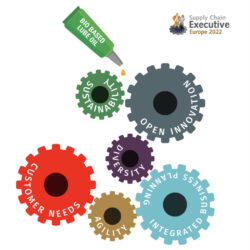Resilient supply chains require resilient supply chain leaders

Making supply chains more resilient has become a major talking point in boardrooms. However, those conversations are led by CEOs who rarely have a background in supply chain. During a recent Webinar Wednesday, McKinsey’s Knut Alicke and e2open’s David Strauss took a closer look at what supply chain leaders need to do to prevent the focus on supply chain from waning.
By Marcel te Lindert
Swedish telecommunications equipment manufacturer Ericsson has performed well by any measure in recent years. In his briefing to investors, Börje Ekholm, the company’s CEO, had a clear explanation why: “We have proactively invested in our supply chain because we have made deliveries our priority. And we have been able to deliver with little or no disruption.”
During the webinar, Knut Alicke referenced Ekholm’s quote in the context of the leadership needed to make supply chains resilient. The partner at consulting firm McKinsey remarked on the fact that the CEO of a leading company like Ericsson even mentioned the word ‘supply chain’. And Ekholm is not the only one: “It seems like supply chain has become a topic of conversation for the board – and not even in a negative sense anymore, but in a positive sense. Senior executives understand that supply chain is important, and that a resilient supply chain helps companies to be successful.”
Meeting expectations
Not only CEOs of internationally operating companies, but also leading politicians are recognizing the importance of supply chains. David Strauss, Vice-President Strategic Partner & Enterprise Solutions at supply chain software vendor e2open, recalled when Angela Merkel first mentioned the word Lieferkette (German for ‘supply chain’), which happened six months into the COVID-19 pandemic. “Suddenly I didn’t have to explain what kind of work I did. That supply chain has become an important topic of conversation is also underlined by new legislation in the US and Europe,” he said.
It is now up to supply chain leaders to keep the momentum going. “Now we have to live up to the high expectations to prevent supply chain from slipping back into second place again six months from now,” Alicke stated. “Nobody wants to hear stories about poorly performing supply chains anymore. Now, everyone wants to hear how well the supply chain is set up and how resistant it is to disruptions,” added Strauss, whose mission at e2open consists of helping organizations to achieve supply chain resilience through a more connected, integrated, harmonized and proactive supply chain.
Supply chain is underrepresented
It will not be easy to sustain the momentum. For their book called From Source to Sold, Alicke and co-author Radu Palamariu analysed how much supply chain knowledge is present within the boards of globally operating companies. They discovered that just 11% of CEOs of Fortune 200 companies have a background in supply chain, and only 13% have a CSCO on the board. “That’s not a lot,” said Alicke. “It’s safe to say that supply chain is underrepresented on the board.”
Both Alicke and Strauss are convinced that this will change in the future, simply because the importance of supply chain has increased considerably. To inspire more supply chain professionals to work their way up to board level, Alicke and his co-author conducted interviews with 26 leaders who have already succeeded. These include CSCOs such as Ivanka Janssen (Philips), Sami Naffakh (Reckitt) and Dirk Holbach (Henkel). “We wanted to know what can be learned from them, and which career paths they took,” Alicke explained.
CSCOs are eager to learn
One thing Alicke noticed is that all 26 leaders are very eager to learn and are willing to work on their own development. For example, one CSCO did a Python training course during the summer holidays. “That CSCO wanted to stay up-to-date and understand how the data analysts within the company think and work. Other CSCOs use reversed mentoring. We learned a lot from the interviews,” continued Alicke.
Besides the CSCOs, their boardroom colleagues will also have to learn a thing or two about supply chains. Many still think their company’s supply chain consists only of its own factories and distribution centres. “But today’s supply chains have become so much more complex. No consumer electronics suppliers make their own chips nowadays. And even the assembly of laptops and smartphones is often outsourced, and those suppliers are rarely on the doorstep. That means you no longer have full control over many elements of the product,” Strauss says.
Globalization vs regionalization
The supply chain has become a lot more complex on the demand side as well as the supply side. For example, many brand owners work with regional and local distributors before the product reaches retail stores. Strauss: “If something unexpected happens at the retailer, it is difficult to respond quickly if the links in the supply chain are not well connected. Many companies rely on their ERP systems, but that is not enough to run a business today. The successful companies invest in technology that interlinks the various parts of the supply chain and enables end-to-end supply chain planning.”
Alicke does not expect supply chains to become much less complex anytime soon. Analysis by McKinsey shows that no region – not even China – is self-sufficient in any area. In other words, regions are interdependent, so there is no end in sight for globalization for the time being. “Look at the manufacturers of microchips. Their decisions about the location of new production sites depend mainly on which government provides the most subsidies. Yet in the past ten years, no more than 21% of the chip production capacity has been relocated. So we’re unlikely to see the entire production capacity being moved elsewhere in the next two to three years.”
CHAIN model
In other words, regionalization is not the only answer to the question of how supply chains can be made more resilient. Companies are of course reassessing their network and exploring reshoring opportunities. But in addition, resilience can be improved in three other ways: through supply chain planning, digitalization and risk management. “Planning is crucial, especially scenario planning. A strong IT infrastructure is required to adequately analyse different scenarios. In addition, there is a growing need for close collaboration with customers and suppliers.”
Building resilient supply chains requires the right leadership skills. Based on the 26 interviews with supply chain leaders, Alicke and his co-author created the CHAIN model, in which CHAIN stands for Collaborative, Holistic, Adaptable, Influential and Narrative. “Those leaders think in terms of both internal and external collaboration. They look not only at the internal supply chain, but also at the entire end-to-end supply chain. They understand that supply chain will always be subject to change. And lastly, they need to know how to explain the importance of supply chain in simple terms.”










